Critical Review: Good for Health, Good for Business: Tobacco Use
VerifiedAdded on 2023/01/04
|9
|2571
|94
Report
AI Summary
This report presents a critical review of the business case for reducing tobacco use, focusing on the positive impacts of smoke-free workplaces on employee health and productivity. The review analyzes arguments related to the topic, evaluates the sources of information and data used, and explores the economic benefits of reducing tobacco use, such as decreased healthcare costs and increased productivity. It highlights the importance of smoking cessation programs and the implementation of tobacco-free policies to improve employee well-being and reduce absenteeism. The report emphasizes the role of businesses in promoting a healthy environment and the economic advantages of supporting employees in quitting smoking, ultimately contributing to improved health outcomes and financial prosperity. The conclusion reinforces the need for businesses to adopt strategies that encourage employees to quit smoking and to create smoke-free workplaces, underscoring the substantial benefits for both employees and the organization.
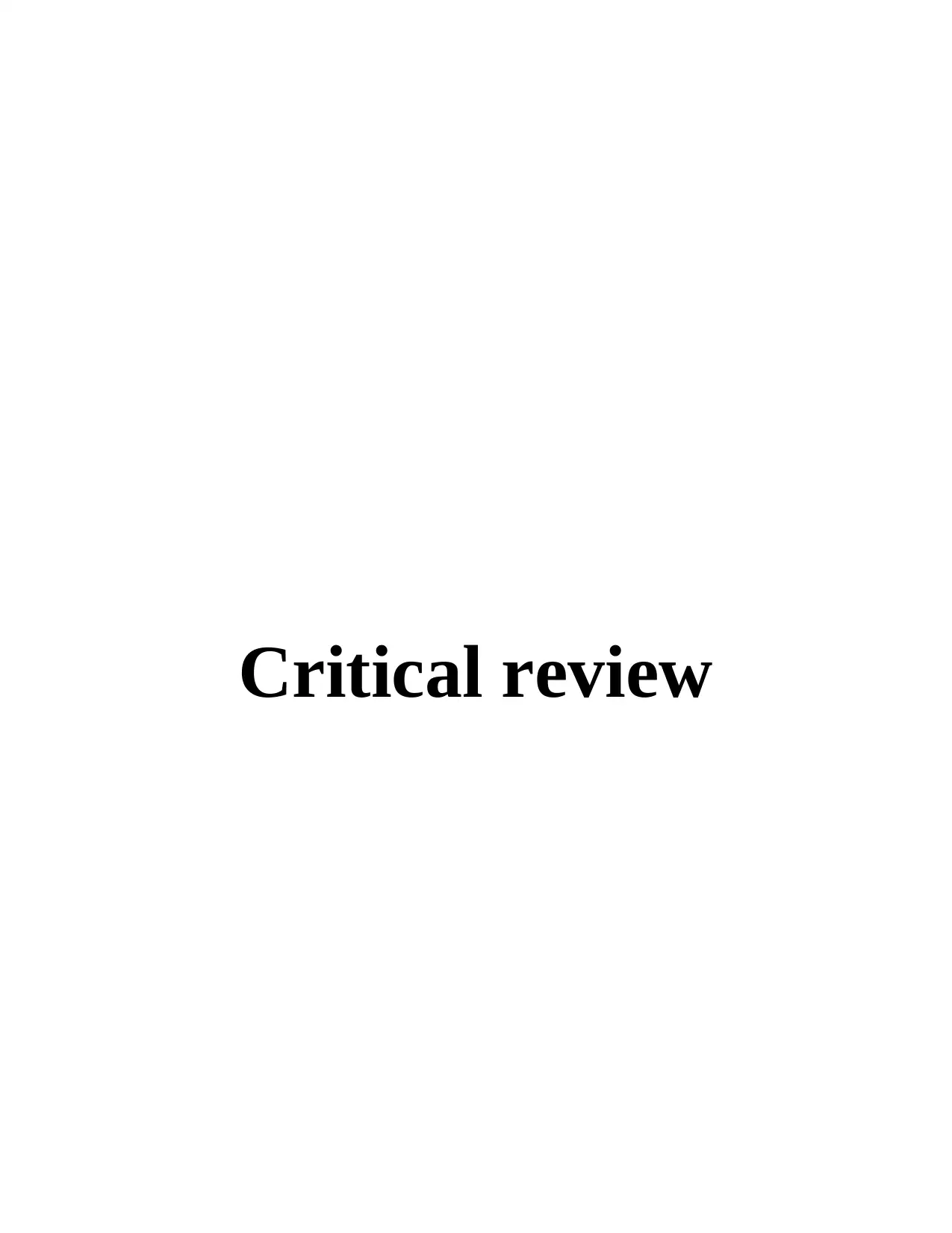
Critical review
Paraphrase This Document
Need a fresh take? Get an instant paraphrase of this document with our AI Paraphraser
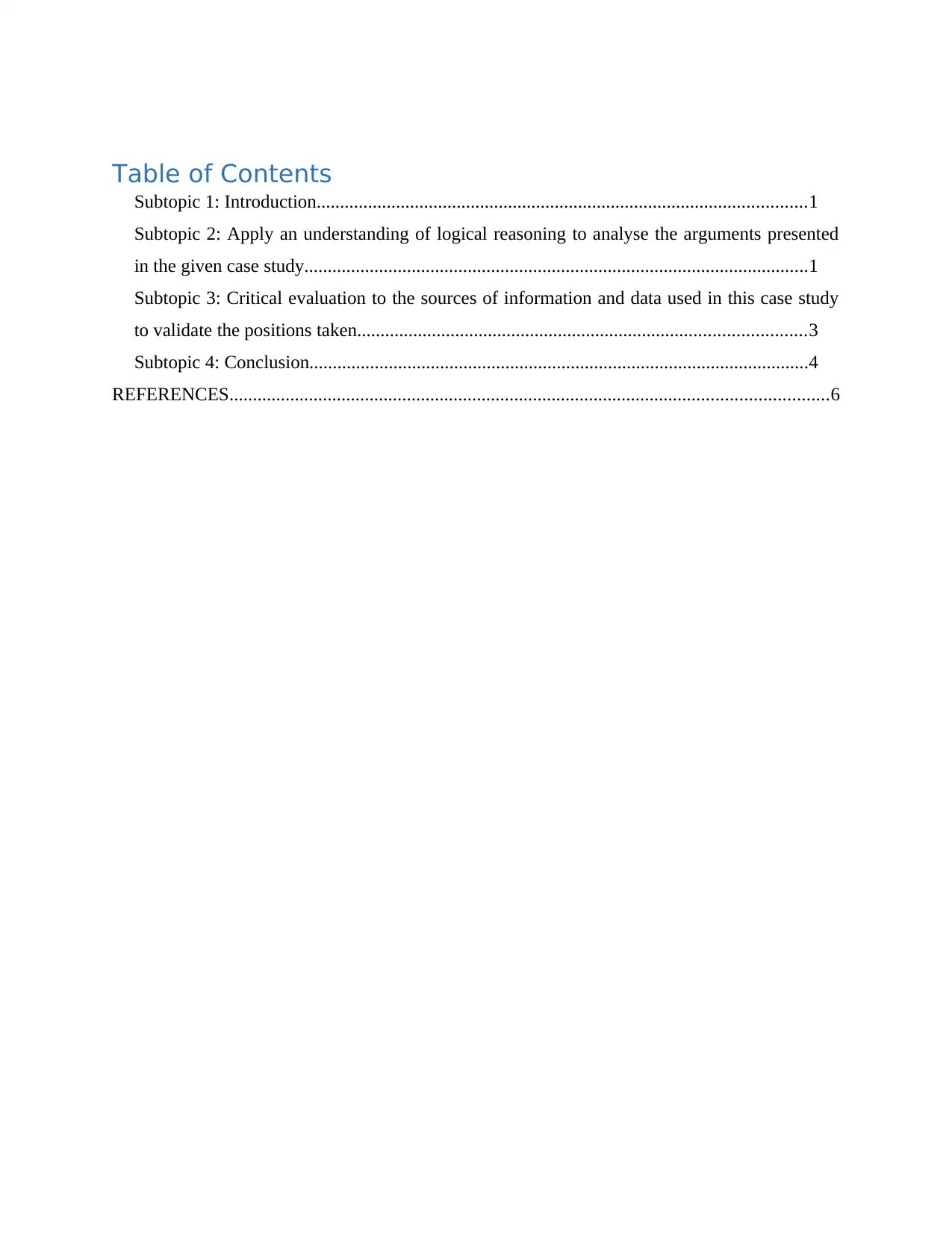
Table of Contents
Subtopic 1: Introduction.........................................................................................................1
Subtopic 2: Apply an understanding of logical reasoning to analyse the arguments presented
in the given case study............................................................................................................1
Subtopic 3: Critical evaluation to the sources of information and data used in this case study
to validate the positions taken................................................................................................3
Subtopic 4: Conclusion...........................................................................................................4
REFERENCES................................................................................................................................6
Subtopic 1: Introduction.........................................................................................................1
Subtopic 2: Apply an understanding of logical reasoning to analyse the arguments presented
in the given case study............................................................................................................1
Subtopic 3: Critical evaluation to the sources of information and data used in this case study
to validate the positions taken................................................................................................3
Subtopic 4: Conclusion...........................................................................................................4
REFERENCES................................................................................................................................6
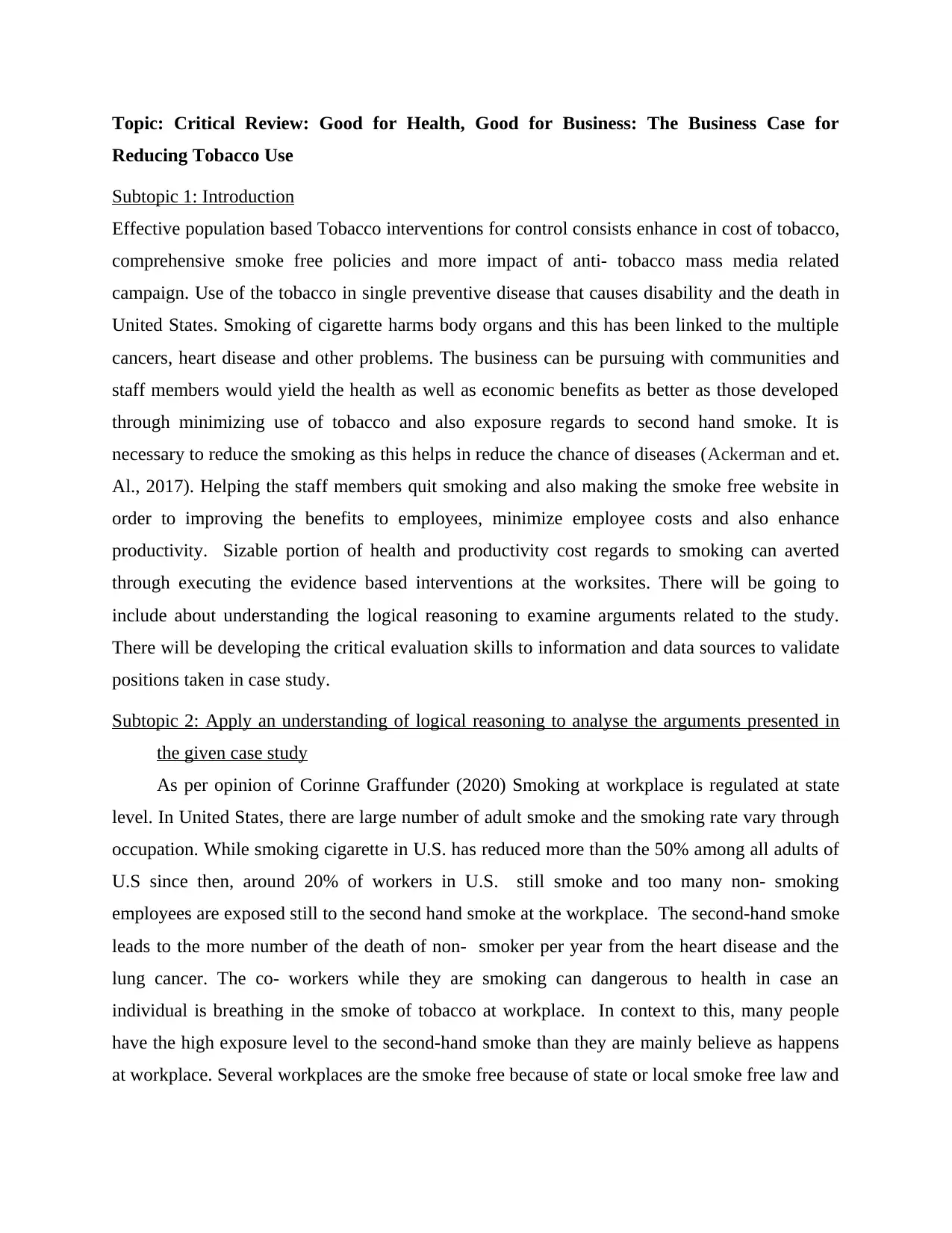
Topic: Critical Review: Good for Health, Good for Business: The Business Case for
Reducing Tobacco Use
Subtopic 1: Introduction
Effective population based Tobacco interventions for control consists enhance in cost of tobacco,
comprehensive smoke free policies and more impact of anti- tobacco mass media related
campaign. Use of the tobacco in single preventive disease that causes disability and the death in
United States. Smoking of cigarette harms body organs and this has been linked to the multiple
cancers, heart disease and other problems. The business can be pursuing with communities and
staff members would yield the health as well as economic benefits as better as those developed
through minimizing use of tobacco and also exposure regards to second hand smoke. It is
necessary to reduce the smoking as this helps in reduce the chance of diseases (Ackerman and et.
Al., 2017). Helping the staff members quit smoking and also making the smoke free website in
order to improving the benefits to employees, minimize employee costs and also enhance
productivity. Sizable portion of health and productivity cost regards to smoking can averted
through executing the evidence based interventions at the worksites. There will be going to
include about understanding the logical reasoning to examine arguments related to the study.
There will be developing the critical evaluation skills to information and data sources to validate
positions taken in case study.
Subtopic 2: Apply an understanding of logical reasoning to analyse the arguments presented in
the given case study
As per opinion of Corinne Graffunder (2020) Smoking at workplace is regulated at state
level. In United States, there are large number of adult smoke and the smoking rate vary through
occupation. While smoking cigarette in U.S. has reduced more than the 50% among all adults of
U.S since then, around 20% of workers in U.S. still smoke and too many non- smoking
employees are exposed still to the second hand smoke at the workplace. The second-hand smoke
leads to the more number of the death of non- smoker per year from the heart disease and the
lung cancer. The co- workers while they are smoking can dangerous to health in case an
individual is breathing in the smoke of tobacco at workplace. In context to this, many people
have the high exposure level to the second-hand smoke than they are mainly believe as happens
at workplace. Several workplaces are the smoke free because of state or local smoke free law and
Reducing Tobacco Use
Subtopic 1: Introduction
Effective population based Tobacco interventions for control consists enhance in cost of tobacco,
comprehensive smoke free policies and more impact of anti- tobacco mass media related
campaign. Use of the tobacco in single preventive disease that causes disability and the death in
United States. Smoking of cigarette harms body organs and this has been linked to the multiple
cancers, heart disease and other problems. The business can be pursuing with communities and
staff members would yield the health as well as economic benefits as better as those developed
through minimizing use of tobacco and also exposure regards to second hand smoke. It is
necessary to reduce the smoking as this helps in reduce the chance of diseases (Ackerman and et.
Al., 2017). Helping the staff members quit smoking and also making the smoke free website in
order to improving the benefits to employees, minimize employee costs and also enhance
productivity. Sizable portion of health and productivity cost regards to smoking can averted
through executing the evidence based interventions at the worksites. There will be going to
include about understanding the logical reasoning to examine arguments related to the study.
There will be developing the critical evaluation skills to information and data sources to validate
positions taken in case study.
Subtopic 2: Apply an understanding of logical reasoning to analyse the arguments presented in
the given case study
As per opinion of Corinne Graffunder (2020) Smoking at workplace is regulated at state
level. In United States, there are large number of adult smoke and the smoking rate vary through
occupation. While smoking cigarette in U.S. has reduced more than the 50% among all adults of
U.S since then, around 20% of workers in U.S. still smoke and too many non- smoking
employees are exposed still to the second hand smoke at the workplace. The second-hand smoke
leads to the more number of the death of non- smoker per year from the heart disease and the
lung cancer. The co- workers while they are smoking can dangerous to health in case an
individual is breathing in the smoke of tobacco at workplace. In context to this, many people
have the high exposure level to the second-hand smoke than they are mainly believe as happens
at workplace. Several workplaces are the smoke free because of state or local smoke free law and
⊘ This is a preview!⊘
Do you want full access?
Subscribe today to unlock all pages.

Trusted by 1+ million students worldwide
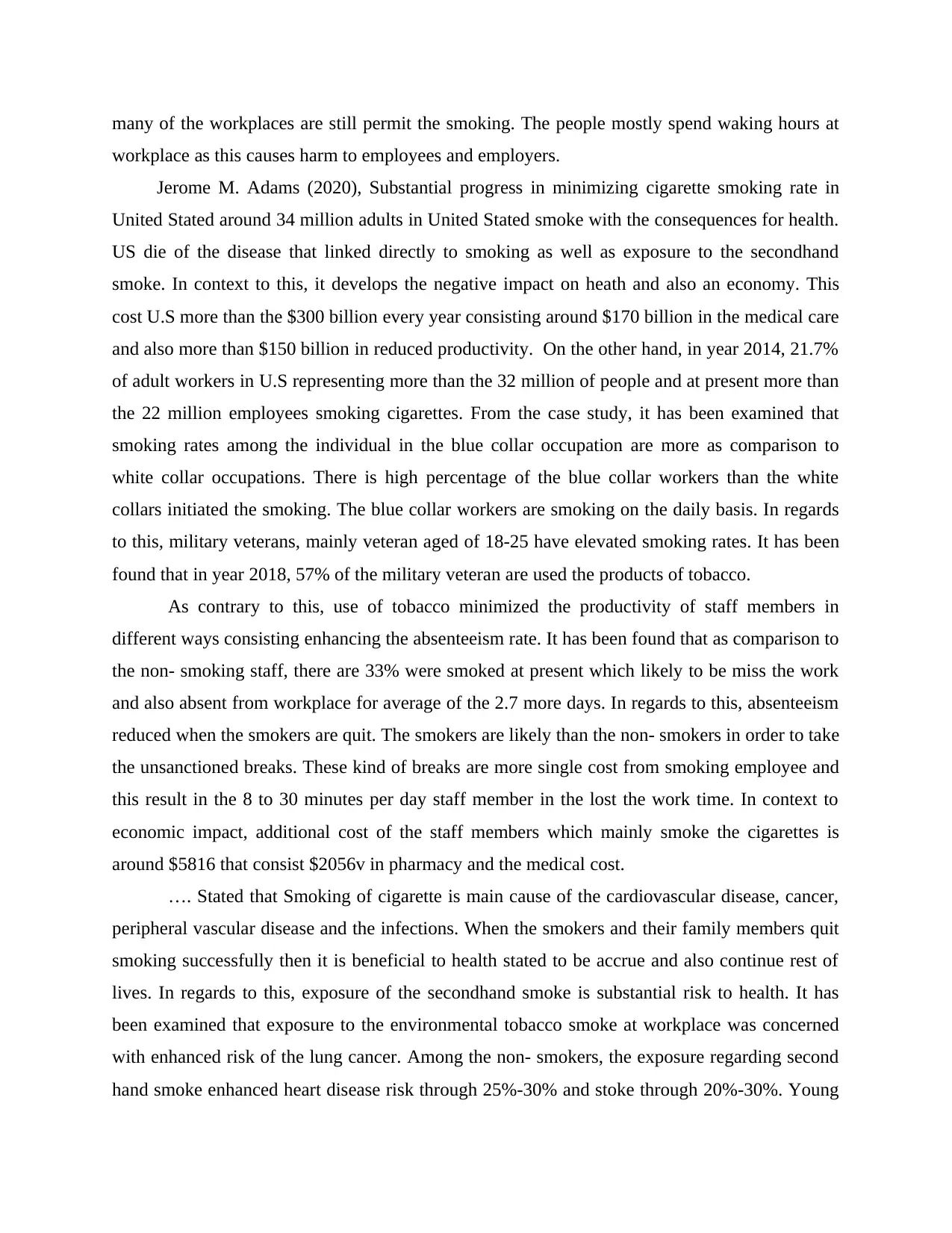
many of the workplaces are still permit the smoking. The people mostly spend waking hours at
workplace as this causes harm to employees and employers.
Jerome M. Adams (2020), Substantial progress in minimizing cigarette smoking rate in
United Stated around 34 million adults in United Stated smoke with the consequences for health.
US die of the disease that linked directly to smoking as well as exposure to the secondhand
smoke. In context to this, it develops the negative impact on heath and also an economy. This
cost U.S more than the $300 billion every year consisting around $170 billion in the medical care
and also more than $150 billion in reduced productivity. On the other hand, in year 2014, 21.7%
of adult workers in U.S representing more than the 32 million of people and at present more than
the 22 million employees smoking cigarettes. From the case study, it has been examined that
smoking rates among the individual in the blue collar occupation are more as comparison to
white collar occupations. There is high percentage of the blue collar workers than the white
collars initiated the smoking. The blue collar workers are smoking on the daily basis. In regards
to this, military veterans, mainly veteran aged of 18-25 have elevated smoking rates. It has been
found that in year 2018, 57% of the military veteran are used the products of tobacco.
As contrary to this, use of tobacco minimized the productivity of staff members in
different ways consisting enhancing the absenteeism rate. It has been found that as comparison to
the non- smoking staff, there are 33% were smoked at present which likely to be miss the work
and also absent from workplace for average of the 2.7 more days. In regards to this, absenteeism
reduced when the smokers are quit. The smokers are likely than the non- smokers in order to take
the unsanctioned breaks. These kind of breaks are more single cost from smoking employee and
this result in the 8 to 30 minutes per day staff member in the lost the work time. In context to
economic impact, additional cost of the staff members which mainly smoke the cigarettes is
around $5816 that consist $2056v in pharmacy and the medical cost.
…. Stated that Smoking of cigarette is main cause of the cardiovascular disease, cancer,
peripheral vascular disease and the infections. When the smokers and their family members quit
smoking successfully then it is beneficial to health stated to be accrue and also continue rest of
lives. In regards to this, exposure of the secondhand smoke is substantial risk to health. It has
been examined that exposure to the environmental tobacco smoke at workplace was concerned
with enhanced risk of the lung cancer. Among the non- smokers, the exposure regarding second
hand smoke enhanced heart disease risk through 25%-30% and stoke through 20%-30%. Young
workplace as this causes harm to employees and employers.
Jerome M. Adams (2020), Substantial progress in minimizing cigarette smoking rate in
United Stated around 34 million adults in United Stated smoke with the consequences for health.
US die of the disease that linked directly to smoking as well as exposure to the secondhand
smoke. In context to this, it develops the negative impact on heath and also an economy. This
cost U.S more than the $300 billion every year consisting around $170 billion in the medical care
and also more than $150 billion in reduced productivity. On the other hand, in year 2014, 21.7%
of adult workers in U.S representing more than the 32 million of people and at present more than
the 22 million employees smoking cigarettes. From the case study, it has been examined that
smoking rates among the individual in the blue collar occupation are more as comparison to
white collar occupations. There is high percentage of the blue collar workers than the white
collars initiated the smoking. The blue collar workers are smoking on the daily basis. In regards
to this, military veterans, mainly veteran aged of 18-25 have elevated smoking rates. It has been
found that in year 2018, 57% of the military veteran are used the products of tobacco.
As contrary to this, use of tobacco minimized the productivity of staff members in
different ways consisting enhancing the absenteeism rate. It has been found that as comparison to
the non- smoking staff, there are 33% were smoked at present which likely to be miss the work
and also absent from workplace for average of the 2.7 more days. In regards to this, absenteeism
reduced when the smokers are quit. The smokers are likely than the non- smokers in order to take
the unsanctioned breaks. These kind of breaks are more single cost from smoking employee and
this result in the 8 to 30 minutes per day staff member in the lost the work time. In context to
economic impact, additional cost of the staff members which mainly smoke the cigarettes is
around $5816 that consist $2056v in pharmacy and the medical cost.
…. Stated that Smoking of cigarette is main cause of the cardiovascular disease, cancer,
peripheral vascular disease and the infections. When the smokers and their family members quit
smoking successfully then it is beneficial to health stated to be accrue and also continue rest of
lives. In regards to this, exposure of the secondhand smoke is substantial risk to health. It has
been examined that exposure to the environmental tobacco smoke at workplace was concerned
with enhanced risk of the lung cancer. Among the non- smokers, the exposure regarding second
hand smoke enhanced heart disease risk through 25%-30% and stoke through 20%-30%. Young
Paraphrase This Document
Need a fresh take? Get an instant paraphrase of this document with our AI Paraphraser
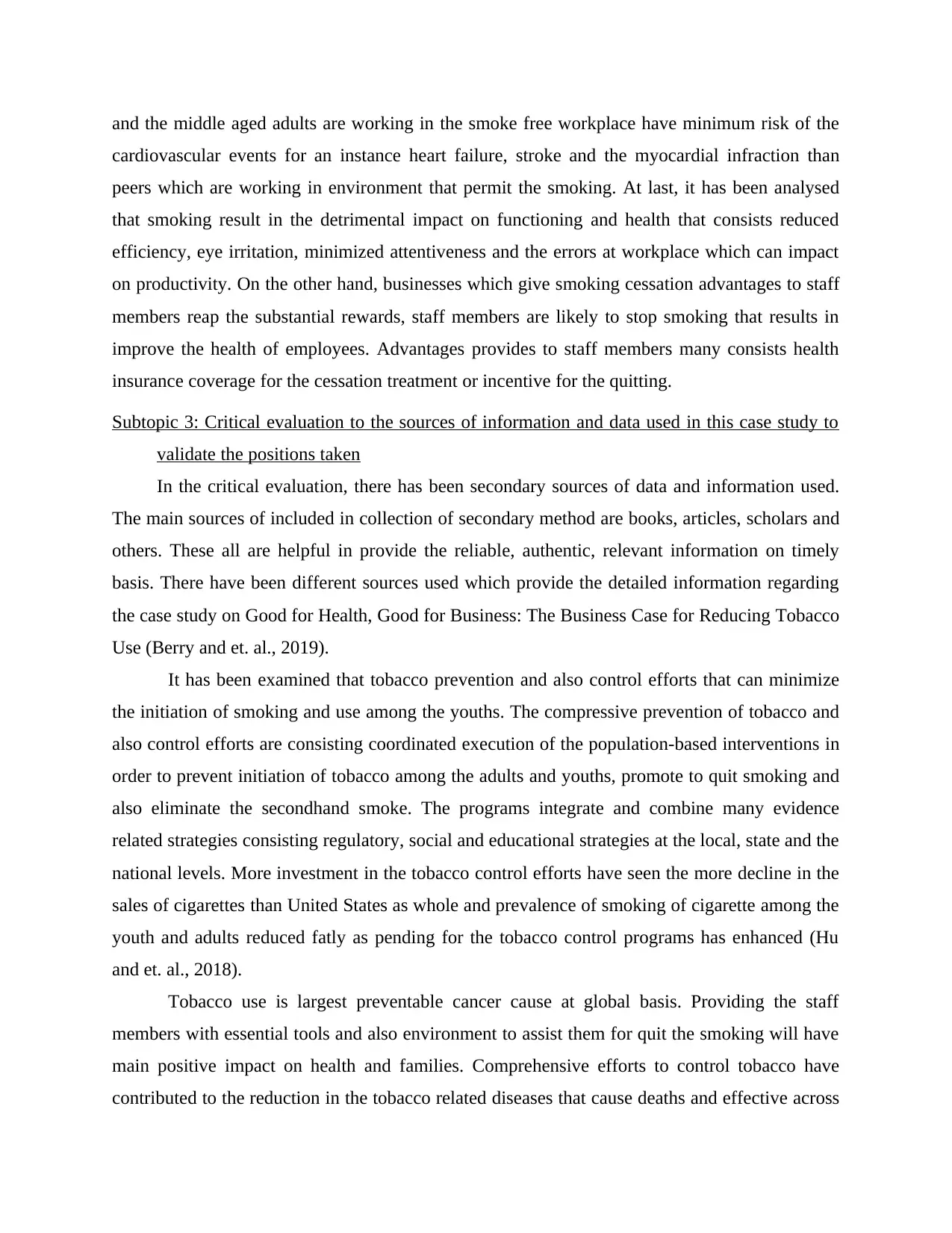
and the middle aged adults are working in the smoke free workplace have minimum risk of the
cardiovascular events for an instance heart failure, stroke and the myocardial infraction than
peers which are working in environment that permit the smoking. At last, it has been analysed
that smoking result in the detrimental impact on functioning and health that consists reduced
efficiency, eye irritation, minimized attentiveness and the errors at workplace which can impact
on productivity. On the other hand, businesses which give smoking cessation advantages to staff
members reap the substantial rewards, staff members are likely to stop smoking that results in
improve the health of employees. Advantages provides to staff members many consists health
insurance coverage for the cessation treatment or incentive for the quitting.
Subtopic 3: Critical evaluation to the sources of information and data used in this case study to
validate the positions taken
In the critical evaluation, there has been secondary sources of data and information used.
The main sources of included in collection of secondary method are books, articles, scholars and
others. These all are helpful in provide the reliable, authentic, relevant information on timely
basis. There have been different sources used which provide the detailed information regarding
the case study on Good for Health, Good for Business: The Business Case for Reducing Tobacco
Use (Berry and et. al., 2019).
It has been examined that tobacco prevention and also control efforts that can minimize
the initiation of smoking and use among the youths. The compressive prevention of tobacco and
also control efforts are consisting coordinated execution of the population-based interventions in
order to prevent initiation of tobacco among the adults and youths, promote to quit smoking and
also eliminate the secondhand smoke. The programs integrate and combine many evidence
related strategies consisting regulatory, social and educational strategies at the local, state and the
national levels. More investment in the tobacco control efforts have seen the more decline in the
sales of cigarettes than United States as whole and prevalence of smoking of cigarette among the
youth and adults reduced fatly as pending for the tobacco control programs has enhanced (Hu
and et. al., 2018).
Tobacco use is largest preventable cancer cause at global basis. Providing the staff
members with essential tools and also environment to assist them for quit the smoking will have
main positive impact on health and families. Comprehensive efforts to control tobacco have
contributed to the reduction in the tobacco related diseases that cause deaths and effective across
cardiovascular events for an instance heart failure, stroke and the myocardial infraction than
peers which are working in environment that permit the smoking. At last, it has been analysed
that smoking result in the detrimental impact on functioning and health that consists reduced
efficiency, eye irritation, minimized attentiveness and the errors at workplace which can impact
on productivity. On the other hand, businesses which give smoking cessation advantages to staff
members reap the substantial rewards, staff members are likely to stop smoking that results in
improve the health of employees. Advantages provides to staff members many consists health
insurance coverage for the cessation treatment or incentive for the quitting.
Subtopic 3: Critical evaluation to the sources of information and data used in this case study to
validate the positions taken
In the critical evaluation, there has been secondary sources of data and information used.
The main sources of included in collection of secondary method are books, articles, scholars and
others. These all are helpful in provide the reliable, authentic, relevant information on timely
basis. There have been different sources used which provide the detailed information regarding
the case study on Good for Health, Good for Business: The Business Case for Reducing Tobacco
Use (Berry and et. al., 2019).
It has been examined that tobacco prevention and also control efforts that can minimize
the initiation of smoking and use among the youths. The compressive prevention of tobacco and
also control efforts are consisting coordinated execution of the population-based interventions in
order to prevent initiation of tobacco among the adults and youths, promote to quit smoking and
also eliminate the secondhand smoke. The programs integrate and combine many evidence
related strategies consisting regulatory, social and educational strategies at the local, state and the
national levels. More investment in the tobacco control efforts have seen the more decline in the
sales of cigarettes than United States as whole and prevalence of smoking of cigarette among the
youth and adults reduced fatly as pending for the tobacco control programs has enhanced (Hu
and et. al., 2018).
Tobacco use is largest preventable cancer cause at global basis. Providing the staff
members with essential tools and also environment to assist them for quit the smoking will have
main positive impact on health and families. Comprehensive efforts to control tobacco have
contributed to the reduction in the tobacco related diseases that cause deaths and effective across
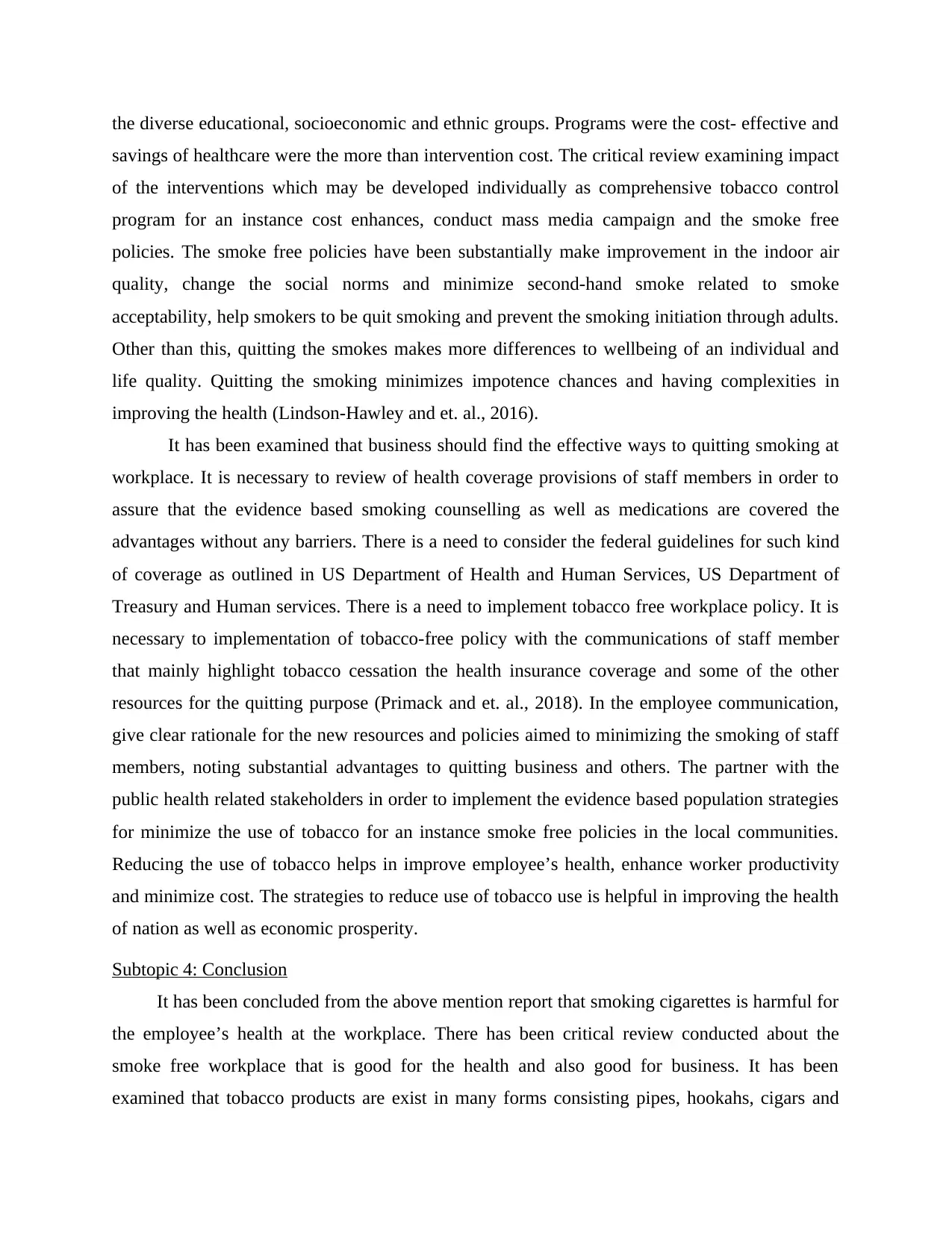
the diverse educational, socioeconomic and ethnic groups. Programs were the cost- effective and
savings of healthcare were the more than intervention cost. The critical review examining impact
of the interventions which may be developed individually as comprehensive tobacco control
program for an instance cost enhances, conduct mass media campaign and the smoke free
policies. The smoke free policies have been substantially make improvement in the indoor air
quality, change the social norms and minimize second-hand smoke related to smoke
acceptability, help smokers to be quit smoking and prevent the smoking initiation through adults.
Other than this, quitting the smokes makes more differences to wellbeing of an individual and
life quality. Quitting the smoking minimizes impotence chances and having complexities in
improving the health (Lindson‐Hawley and et. al., 2016).
It has been examined that business should find the effective ways to quitting smoking at
workplace. It is necessary to review of health coverage provisions of staff members in order to
assure that the evidence based smoking counselling as well as medications are covered the
advantages without any barriers. There is a need to consider the federal guidelines for such kind
of coverage as outlined in US Department of Health and Human Services, US Department of
Treasury and Human services. There is a need to implement tobacco free workplace policy. It is
necessary to implementation of tobacco-free policy with the communications of staff member
that mainly highlight tobacco cessation the health insurance coverage and some of the other
resources for the quitting purpose (Primack and et. al., 2018). In the employee communication,
give clear rationale for the new resources and policies aimed to minimizing the smoking of staff
members, noting substantial advantages to quitting business and others. The partner with the
public health related stakeholders in order to implement the evidence based population strategies
for minimize the use of tobacco for an instance smoke free policies in the local communities.
Reducing the use of tobacco helps in improve employee’s health, enhance worker productivity
and minimize cost. The strategies to reduce use of tobacco use is helpful in improving the health
of nation as well as economic prosperity.
Subtopic 4: Conclusion
It has been concluded from the above mention report that smoking cigarettes is harmful for
the employee’s health at the workplace. There has been critical review conducted about the
smoke free workplace that is good for the health and also good for business. It has been
examined that tobacco products are exist in many forms consisting pipes, hookahs, cigars and
savings of healthcare were the more than intervention cost. The critical review examining impact
of the interventions which may be developed individually as comprehensive tobacco control
program for an instance cost enhances, conduct mass media campaign and the smoke free
policies. The smoke free policies have been substantially make improvement in the indoor air
quality, change the social norms and minimize second-hand smoke related to smoke
acceptability, help smokers to be quit smoking and prevent the smoking initiation through adults.
Other than this, quitting the smokes makes more differences to wellbeing of an individual and
life quality. Quitting the smoking minimizes impotence chances and having complexities in
improving the health (Lindson‐Hawley and et. al., 2016).
It has been examined that business should find the effective ways to quitting smoking at
workplace. It is necessary to review of health coverage provisions of staff members in order to
assure that the evidence based smoking counselling as well as medications are covered the
advantages without any barriers. There is a need to consider the federal guidelines for such kind
of coverage as outlined in US Department of Health and Human Services, US Department of
Treasury and Human services. There is a need to implement tobacco free workplace policy. It is
necessary to implementation of tobacco-free policy with the communications of staff member
that mainly highlight tobacco cessation the health insurance coverage and some of the other
resources for the quitting purpose (Primack and et. al., 2018). In the employee communication,
give clear rationale for the new resources and policies aimed to minimizing the smoking of staff
members, noting substantial advantages to quitting business and others. The partner with the
public health related stakeholders in order to implement the evidence based population strategies
for minimize the use of tobacco for an instance smoke free policies in the local communities.
Reducing the use of tobacco helps in improve employee’s health, enhance worker productivity
and minimize cost. The strategies to reduce use of tobacco use is helpful in improving the health
of nation as well as economic prosperity.
Subtopic 4: Conclusion
It has been concluded from the above mention report that smoking cigarettes is harmful for
the employee’s health at the workplace. There has been critical review conducted about the
smoke free workplace that is good for the health and also good for business. It has been
examined that tobacco products are exist in many forms consisting pipes, hookahs, cigars and
⊘ This is a preview!⊘
Do you want full access?
Subscribe today to unlock all pages.

Trusted by 1+ million students worldwide
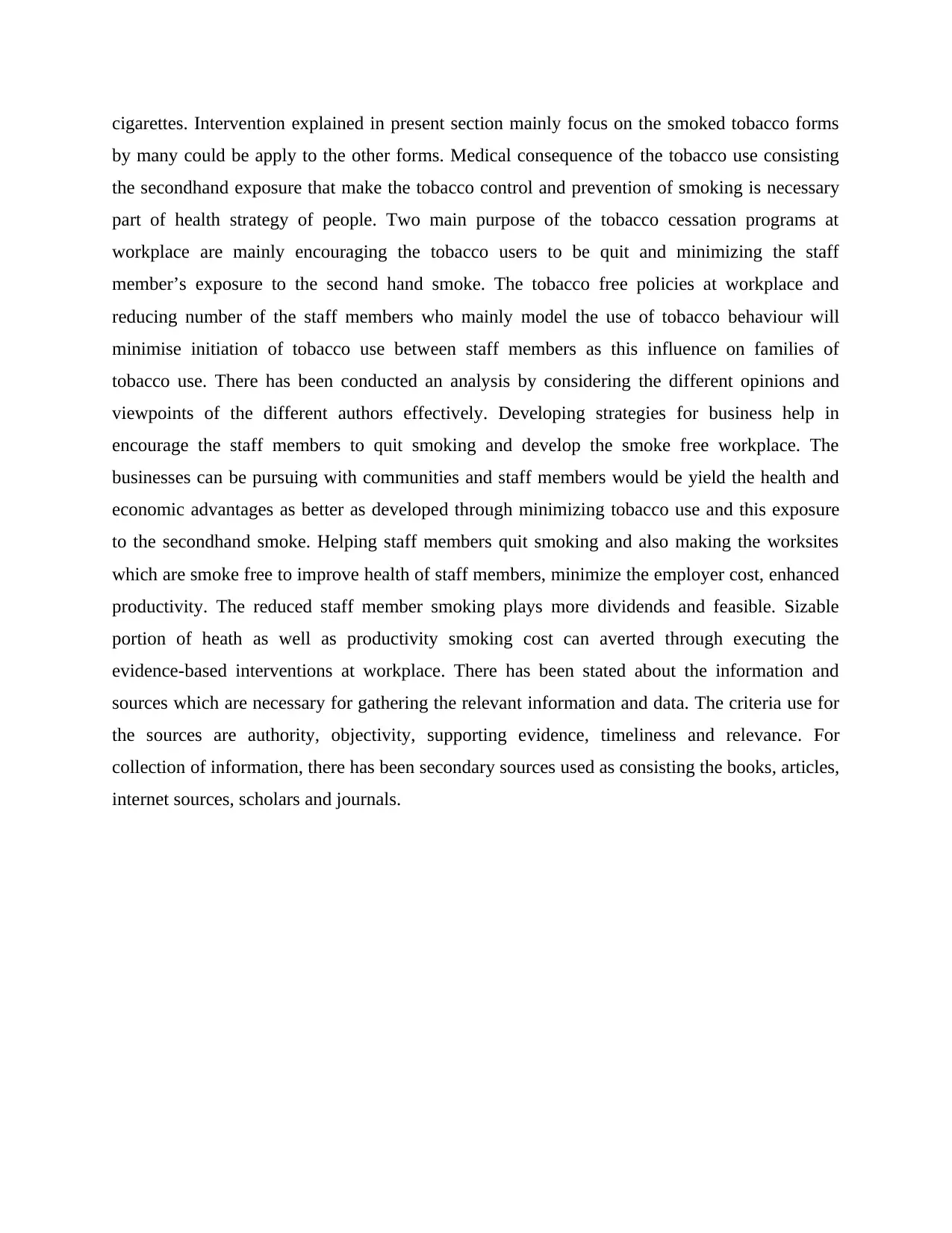
cigarettes. Intervention explained in present section mainly focus on the smoked tobacco forms
by many could be apply to the other forms. Medical consequence of the tobacco use consisting
the secondhand exposure that make the tobacco control and prevention of smoking is necessary
part of health strategy of people. Two main purpose of the tobacco cessation programs at
workplace are mainly encouraging the tobacco users to be quit and minimizing the staff
member’s exposure to the second hand smoke. The tobacco free policies at workplace and
reducing number of the staff members who mainly model the use of tobacco behaviour will
minimise initiation of tobacco use between staff members as this influence on families of
tobacco use. There has been conducted an analysis by considering the different opinions and
viewpoints of the different authors effectively. Developing strategies for business help in
encourage the staff members to quit smoking and develop the smoke free workplace. The
businesses can be pursuing with communities and staff members would be yield the health and
economic advantages as better as developed through minimizing tobacco use and this exposure
to the secondhand smoke. Helping staff members quit smoking and also making the worksites
which are smoke free to improve health of staff members, minimize the employer cost, enhanced
productivity. The reduced staff member smoking plays more dividends and feasible. Sizable
portion of heath as well as productivity smoking cost can averted through executing the
evidence-based interventions at workplace. There has been stated about the information and
sources which are necessary for gathering the relevant information and data. The criteria use for
the sources are authority, objectivity, supporting evidence, timeliness and relevance. For
collection of information, there has been secondary sources used as consisting the books, articles,
internet sources, scholars and journals.
by many could be apply to the other forms. Medical consequence of the tobacco use consisting
the secondhand exposure that make the tobacco control and prevention of smoking is necessary
part of health strategy of people. Two main purpose of the tobacco cessation programs at
workplace are mainly encouraging the tobacco users to be quit and minimizing the staff
member’s exposure to the second hand smoke. The tobacco free policies at workplace and
reducing number of the staff members who mainly model the use of tobacco behaviour will
minimise initiation of tobacco use between staff members as this influence on families of
tobacco use. There has been conducted an analysis by considering the different opinions and
viewpoints of the different authors effectively. Developing strategies for business help in
encourage the staff members to quit smoking and develop the smoke free workplace. The
businesses can be pursuing with communities and staff members would be yield the health and
economic advantages as better as developed through minimizing tobacco use and this exposure
to the secondhand smoke. Helping staff members quit smoking and also making the worksites
which are smoke free to improve health of staff members, minimize the employer cost, enhanced
productivity. The reduced staff member smoking plays more dividends and feasible. Sizable
portion of heath as well as productivity smoking cost can averted through executing the
evidence-based interventions at workplace. There has been stated about the information and
sources which are necessary for gathering the relevant information and data. The criteria use for
the sources are authority, objectivity, supporting evidence, timeliness and relevance. For
collection of information, there has been secondary sources used as consisting the books, articles,
internet sources, scholars and journals.
Paraphrase This Document
Need a fresh take? Get an instant paraphrase of this document with our AI Paraphraser
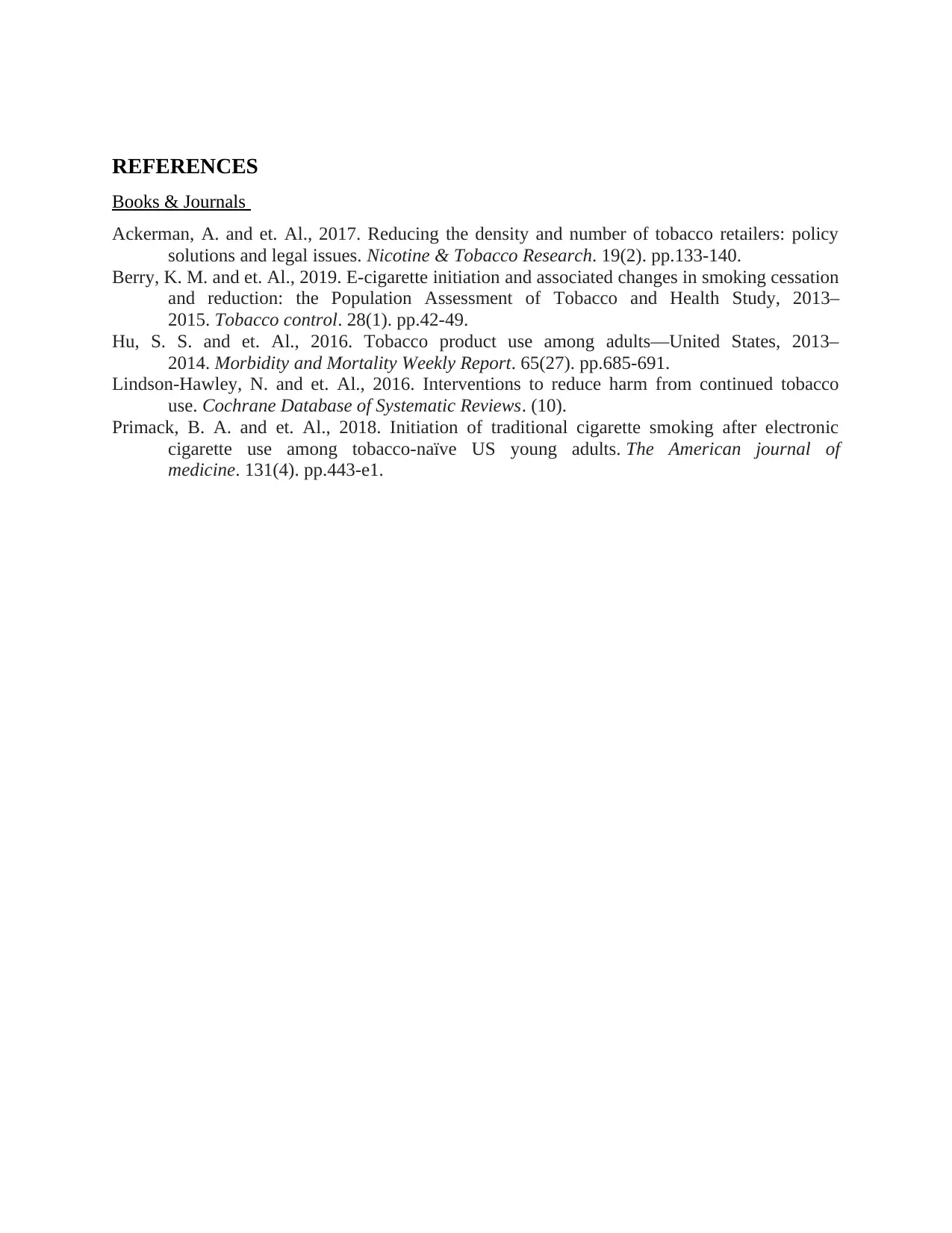
REFERENCES
Books & Journals
Ackerman, A. and et. Al., 2017. Reducing the density and number of tobacco retailers: policy
solutions and legal issues. Nicotine & Tobacco Research. 19(2). pp.133-140.
Berry, K. M. and et. Al., 2019. E-cigarette initiation and associated changes in smoking cessation
and reduction: the Population Assessment of Tobacco and Health Study, 2013–
2015. Tobacco control. 28(1). pp.42-49.
Hu, S. S. and et. Al., 2016. Tobacco product use among adults—United States, 2013–
2014. Morbidity and Mortality Weekly Report. 65(27). pp.685-691.
Lindson‐Hawley, N. and et. Al., 2016. Interventions to reduce harm from continued tobacco
use. Cochrane Database of Systematic Reviews. (10).
Primack, B. A. and et. Al., 2018. Initiation of traditional cigarette smoking after electronic
cigarette use among tobacco-naïve US young adults. The American journal of
medicine. 131(4). pp.443-e1.
Books & Journals
Ackerman, A. and et. Al., 2017. Reducing the density and number of tobacco retailers: policy
solutions and legal issues. Nicotine & Tobacco Research. 19(2). pp.133-140.
Berry, K. M. and et. Al., 2019. E-cigarette initiation and associated changes in smoking cessation
and reduction: the Population Assessment of Tobacco and Health Study, 2013–
2015. Tobacco control. 28(1). pp.42-49.
Hu, S. S. and et. Al., 2016. Tobacco product use among adults—United States, 2013–
2014. Morbidity and Mortality Weekly Report. 65(27). pp.685-691.
Lindson‐Hawley, N. and et. Al., 2016. Interventions to reduce harm from continued tobacco
use. Cochrane Database of Systematic Reviews. (10).
Primack, B. A. and et. Al., 2018. Initiation of traditional cigarette smoking after electronic
cigarette use among tobacco-naïve US young adults. The American journal of
medicine. 131(4). pp.443-e1.
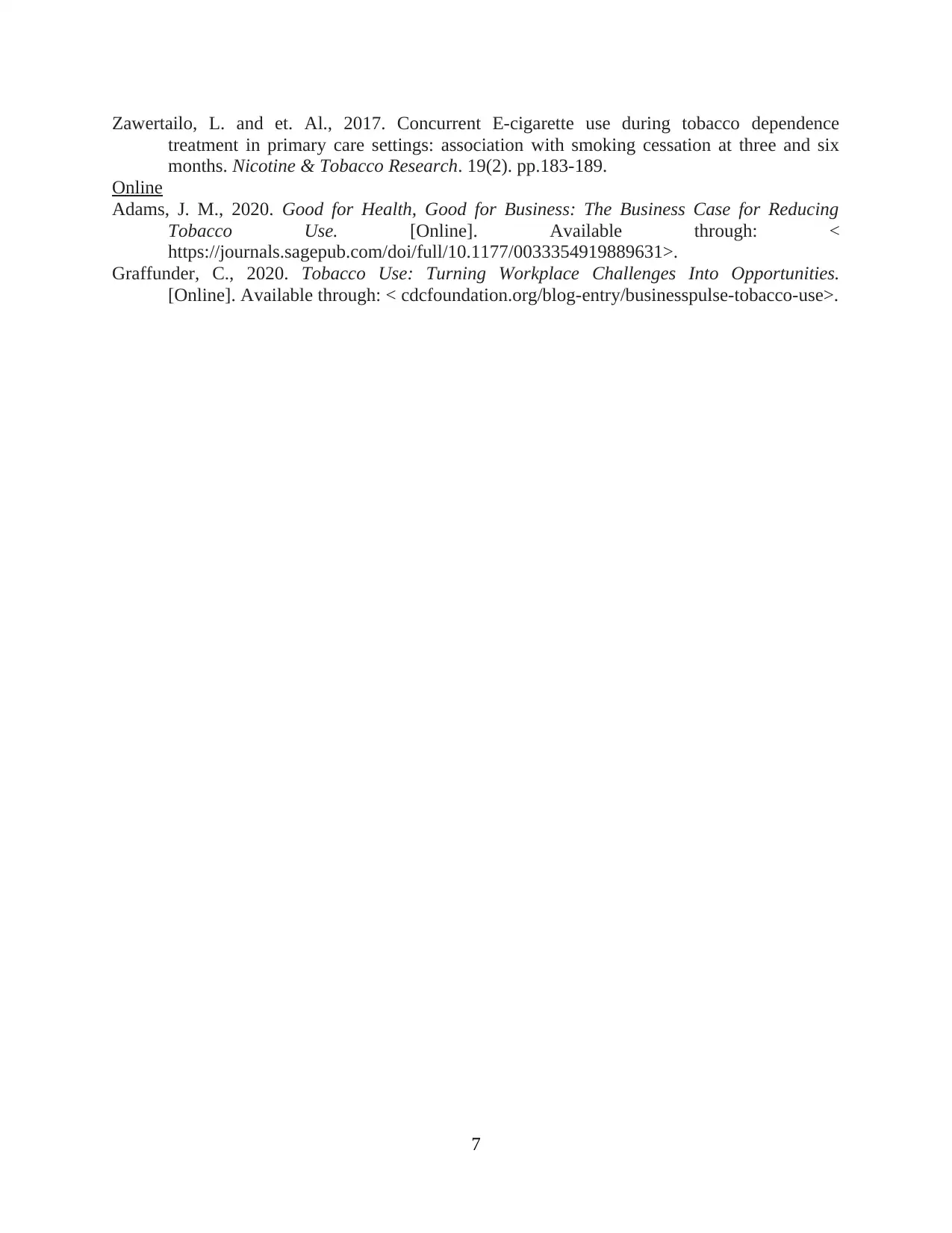
Zawertailo, L. and et. Al., 2017. Concurrent E-cigarette use during tobacco dependence
treatment in primary care settings: association with smoking cessation at three and six
months. Nicotine & Tobacco Research. 19(2). pp.183-189.
Online
Adams, J. M., 2020. Good for Health, Good for Business: The Business Case for Reducing
Tobacco Use. [Online]. Available through: <
https://journals.sagepub.com/doi/full/10.1177/0033354919889631>.
Graffunder, C., 2020. Tobacco Use: Turning Workplace Challenges Into Opportunities.
[Online]. Available through: < cdcfoundation.org/blog-entry/businesspulse-tobacco-use>.
7
treatment in primary care settings: association with smoking cessation at three and six
months. Nicotine & Tobacco Research. 19(2). pp.183-189.
Online
Adams, J. M., 2020. Good for Health, Good for Business: The Business Case for Reducing
Tobacco Use. [Online]. Available through: <
https://journals.sagepub.com/doi/full/10.1177/0033354919889631>.
Graffunder, C., 2020. Tobacco Use: Turning Workplace Challenges Into Opportunities.
[Online]. Available through: < cdcfoundation.org/blog-entry/businesspulse-tobacco-use>.
7
⊘ This is a preview!⊘
Do you want full access?
Subscribe today to unlock all pages.

Trusted by 1+ million students worldwide
1 out of 9
Related Documents
Your All-in-One AI-Powered Toolkit for Academic Success.
+13062052269
info@desklib.com
Available 24*7 on WhatsApp / Email
![[object Object]](/_next/static/media/star-bottom.7253800d.svg)
Unlock your academic potential
Copyright © 2020–2025 A2Z Services. All Rights Reserved. Developed and managed by ZUCOL.





